
The word STÖVARE (pronounced STOVAR…the ‘e’ is silent), literally translated, means HARRIER, and refers to any hunting hound.
The Hamiltonstövare is the official, and most popular hound of Sweden. Its history goes as far back at the 16th.century. It is named after the founder of the Swedish Kennel Club, Count Adolf Patrik Hamilton, the founder of the breed, based on English Foxhounds and German hounds. The breed was first recognised in 1921. Unlike most hounds he works alone or in couple and is used to find and flush game back to the gun, normally fox and hare. The Hamiltonstövare has an excellent nose and when on the trail is hard to distract, and will only return when he is ready. Clearly, a hound who needs a secure garden and who should be exercised with due consideration for roads and livestock.He has gained great affection in his Swedish homeland and is mentioned in folklore; A small elf called Tomten, accompanied by a Hamiltonstövare named Karo, is said to help Swedish housewives.
Although they are still classed as a rare breed in the UK , which means they are not awarded Challenge Certificates and so cannot earn the title of UK Champion, they have achieved a very high standard and succeed at high levels of competition against other breeds. Challenge Certificates ARE, however awarded throughout Europe and, providing the hound is classed as ‘EXCELLENT’ by the judge, after acquiring the required number of certificates, the hound can eventually become a Champion.As his Foxhound ancestry would suggest, the Hamiltonstövare does enjoy plenty of exercise and this must be taken into consideration before acquiring one. Do not expect him to return when called. His temperament is good; even-tempered and friendly he makes a fine house dog as long as his exercise requirements are attended to.The Hamiltonstovare should be rectangularly, proportionally and beautifully built, giving the impression of great strength and stamina without being heavy. It is tricoloured. The ideal size for males is 57 cm (22,5 inches) and for females 53 cm (21 inches)
To read the Kennel Club Breed Standard for the Hamiltonstövare click HERE
To read the FCI Breed Standard for the Hamiltonstövare click HERE
Hamiltonstövare Breed Club of Great Britain
HAMILTONSTÖVARE FEATURE
by
Martin Leigh
THIS FEATURE WAS COMMISSIONED AND PUBLISHED BY ‘OUR DOGS’ NEWSPAPER / MAGAZINE ON 13th. OCTOBER 2017
HISTORY
The word ‘STÖVARE’ (pronounced ‘stervair’), when literally translated, means ‘Harrier’
and The Hamiltonstὄvare is one of the most popular of the hunting breeds in its native
Sweden. It is a scent hound with exceptional scenting abilities which was created by an
eminent Swedish nobleman and dog fancier, Count Adolph Patrick Hamilton, who was to
become the founder of the Swedish Kennel Club in 1889.
Up to 1921 the Hamiltonstὄvare was just known as ‘The Swedish Hound’, but, moves were
then made to standardise the breed in order to distinguish it from other Swedish hounds.
To celebrate the man who had created the breed, and did so much for dogs in general, in
Sweden, the breed was given his name. Hamiltonstὄvare is the same both singularly or
plural. There is never an ‘S’ on the end to pluralise the name.
Hamiltonstὄvare are somewhat similar to the English Foxhound; hardly surprising when
one realises that Foxhounds and Harriers are in their make-up, along with Swiss Hounds
and a mixture of eastern European hounds going back to the 15th & 16th centuries, notably
the Hanover Hound and Holstein Hound, these being the foundation of the breed.

In the Hamiltonstὄvare breeders sought a tough hound, capable of working on their own,
or in couple, in the bitterly cold weather conditions of Northern Sweden, instead of in a
pack. These hounds needed to have exceptional scenting abilities, enabling them to hunt
snow hare and fox. They were bred not to kill their quarry but to drive the game towards
the huntsman, whilst giving voice. The huntsman, listening to the hound’s voice, would
know from which direction the game would appear, enabling him to dispatch it with their
gun. This is a method still used to this day.
HAMILTONSTÖVARE IN RECENT YEARS
In Sweden, field trials for Stὄvare are extremely popular and to gain the title of
‘Champion’ in the breed the hound must become a field champion in addition to a ‘show’
champion. They are never recognised as just ‘Show Champions’. Whilst the
Hamiltonstὄvare is first and foremost a working/hunting hound in Sweden, and shown
only occasionally, there have been exceptions to the rule, notably Mrs Gerd FlyckPederson of the Hubbestad affix, who’s bitch ‘SPORTS STRIMMA’ was runner-up Show
Dog of the year in 1968, and Bjὄrn Larsson’s ‘SWEDISH CHAMPION RAXA’, featured in
HUND SPORT magazine, as the perfect model for the breed. Not only was she an
accomplished hunter but also she was Top Winning Show Hound in Sweden in both 1991
and 1992. This adaptability to the show scene has been well borne out in the United
Kingdom and can be credited to the Hamilton’s intelligence, willingness to please and
happy-go-lucky temperament.
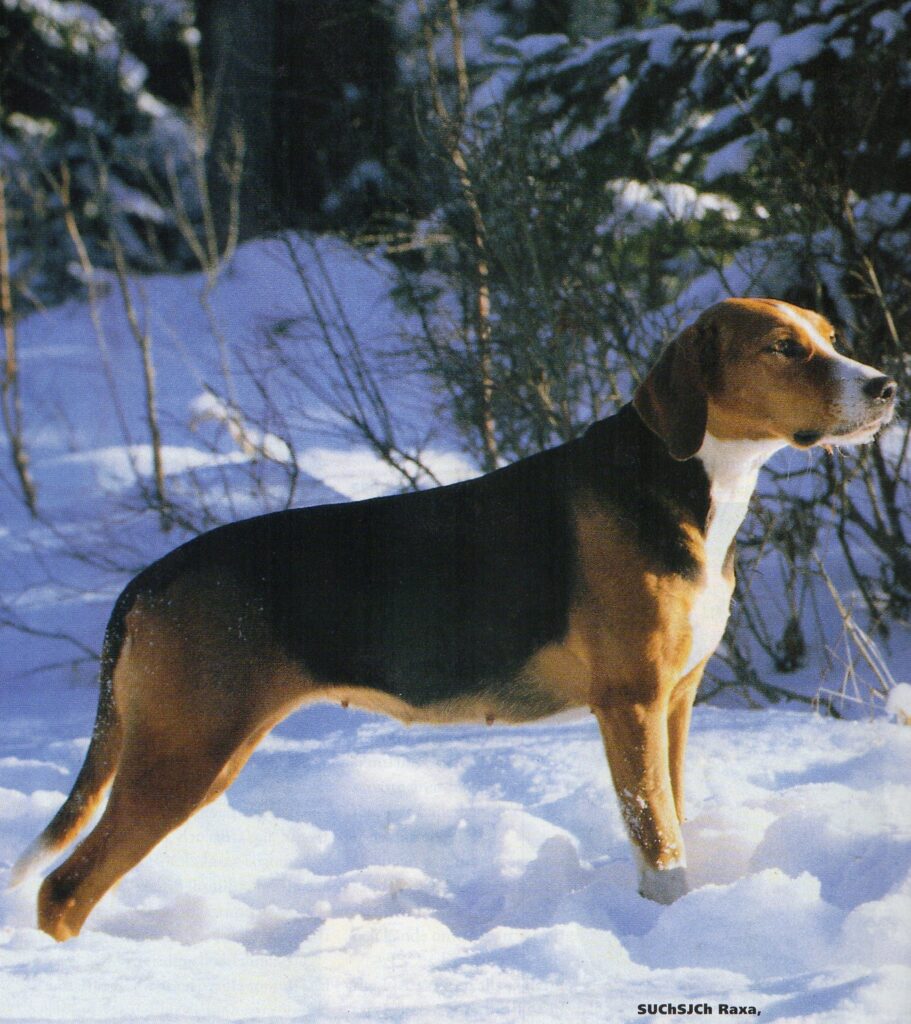
Naturally, because of a ‘Hunting with dog’s ban’ in the United Kingdom, Hamiltonstὄvare
are not worked in the field but, because of their gentle nature, beauty, and devotion to
their human family, they have won the admiration and hearts of many.
The first documented Hamiltonstὄvare in the UK were owned by June & Martin Lacey of
the ‘Rafters’ affix, who, in the late 1960’s, imported three Hamiltonstὄvare; bred a couple
of litters, of which one puppy was Mrs. Veronica Ross’s Rafters Jay of Verwood. Sadly
these breeding lines died out. Miss Valerie Andrews of the Druan Affix was perhaps one of
the first owners, following on from this, when she brought in ‘FLIKA’, which was not used
for breeding. Miss Andrews did, however, import two further Hamiltons from Sweden
‘Goldika Of Druan’ and Ljungasens Boy At Druan. The latter of these two was chosen for
Miss Andrews by the Chairman of The Swedish Kennel Club and was of excellent
confirmation with sound movement. Both of these imports have appeared on the
pedigrees of most Hamiltons in the UK. It was a mating of Miss Andrews’ imports which
produced ‘Druan Dash Of Tedandi’ and ‘Druan Dansa Of Tedandi’, part of the foundation
stock of Diane & Michael Cook’s Tedandi Kennels. ‘Dash’ was the Top Winning Hamilton
for 5 years running in the late 1980’s and was the very first Hamilton in the UK, to win
Best In Show. This was in 1989 at The Hound Club Of East Anglia Show, judged by Denys
Simpson.

Another of the litter was ‘Druan Dikita of Bynton’, which became the foundation bitch of
Julia and Peter Swinburn’s Bynton Kennels. They then imported a male, ‘Max of Bynton’
from Norway to extend their Hamilton kennels.
Two further Hamilton males and a bitch were imported from Sweden, around the same
time as Miss Andrew’s imports, by Mrs. Barbara Stewart, namely ‘Hobergets ‘Zeba’, ‘Atos’
and ‘Acke’, all ‘Of Barclan’ plus a short time later, a further male, ‘Långmarkens Lord’.
Mrs. Stewart bred several litters; from the first litter of ‘Zeba’ & ‘Acke’ one was to become
an addition to The Tedandi kennels, namely ‘Barclan Zita of Tedandi’. From the same litter
‘Barclan Zola of Marshcourt’ became the foundation of Miss Angela Goddard’s
Marshcourt Hamiltonstὄvare kennel. This bitch was mated to ‘Atos’ and a son from this
mating, ‘Marshcourt Mutiny at Burberry’, owned by Alison Woolley, was mated to
‘Dansa’, thus tying up the ‘Druan’ & ‘Barclan’ lines. Alison Woolley moved to New Zealand
and made up the first Hamiltonstὄvare Champions, namely ‘NZ Ch. Tedandi Dr Finlay’ and
‘NZ Ch. Social Climber Of Tedandi’, The ‘Barclan’ kennels was disbanded in the early
1990’s.
‘Barclan Zita of Tedandi’ was mated to Miss Andrews’ Ljungasens Boy’ and produced a dog
and a bitch. The dog ‘Tedandi Dennis The Menace’ was to become not only an outstanding
show dog but a superb stud dog.
Whilst there were some Hamiltonstὄvare in the show ring in the UK during the late ‘80’s it
was Diane Cook of the Tedandi affix who had the foresight to realise that it would not be
many years before the current gene pool would be depleted and, to this end, made efforts
to bring new bloodlines in from Sweden. Breeders, in those days, were extremely
reluctant to allow their stock to come to the UK, as they considered their hounds to be
primarily ‘hunting hounds’ and believed they should be used for that purpose. Coming up
against a ‘brick wall’ she decided, in late 1991, to ask Liz Cartledge, eminent Swedish born
dog breeder and judge of the Ryslip kennels in Berkshire, for help in acquiring new stock,
As Liz owned Ryslip Quarantine Kennels, Diane considered her as the ideal person to help.
Liz enlisted the help of Mr Leonard Pagliero OBE, FCIS, President of The Hound Association
and once Chairman of The Kennel Club as It was thought that his ‘weight’ behind a
possible importation of new stock, may help, which, fortunately it did.
Diane began the formation of a syndicate of eight Hamilton breed enthusiasts, namely
‘Diane Cook, Michael Cook, Sharon Daly, Ian Daly, Martin Leigh, Helen Leigh, Pat Keegan &
Alison Muller’. Together they financed the purchase, importation and quarantine costs of
‘FREDMARKENS KARAT’, a son of ‘Swedish Champion Raxa’ & sired by ‘Swedish Champion
Långmarkens Frisco’, bred by Bjὄrn Larsson & ‘HEJJADALENS MIMMI’, bred by Johnny
Rudbrant from ‘Swedish Champion Ajja’, a full Sister of ‘Raxa, sired by ‘Harlyckans Skått’.
Both ‘Karat’ & ‘Mimmi’ had successful show careers, obtaining over twenty Best Of Breed
wins between them. Both of them achieved Best In Show wins at The Hamiltonstὄvare
Club Of Great Britain club shows. ‘Karat’ was also awarded Best Of Breed at Crufts in 1994
& 1996.
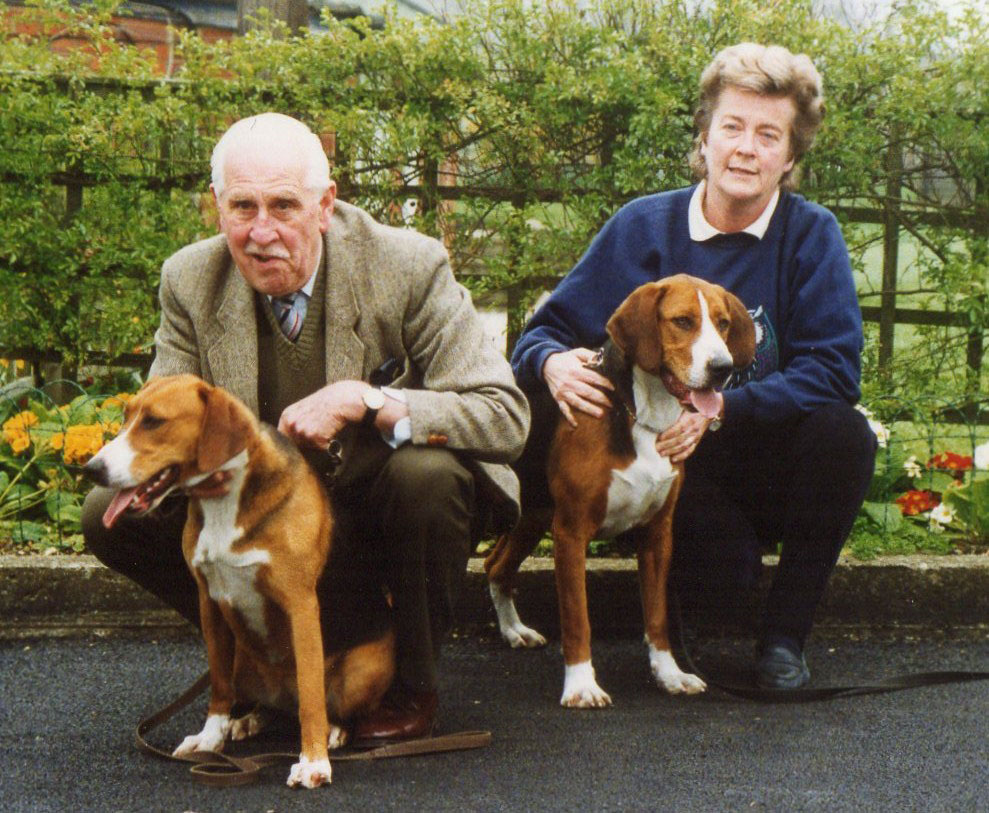
Pagliero & Liz Cartledge
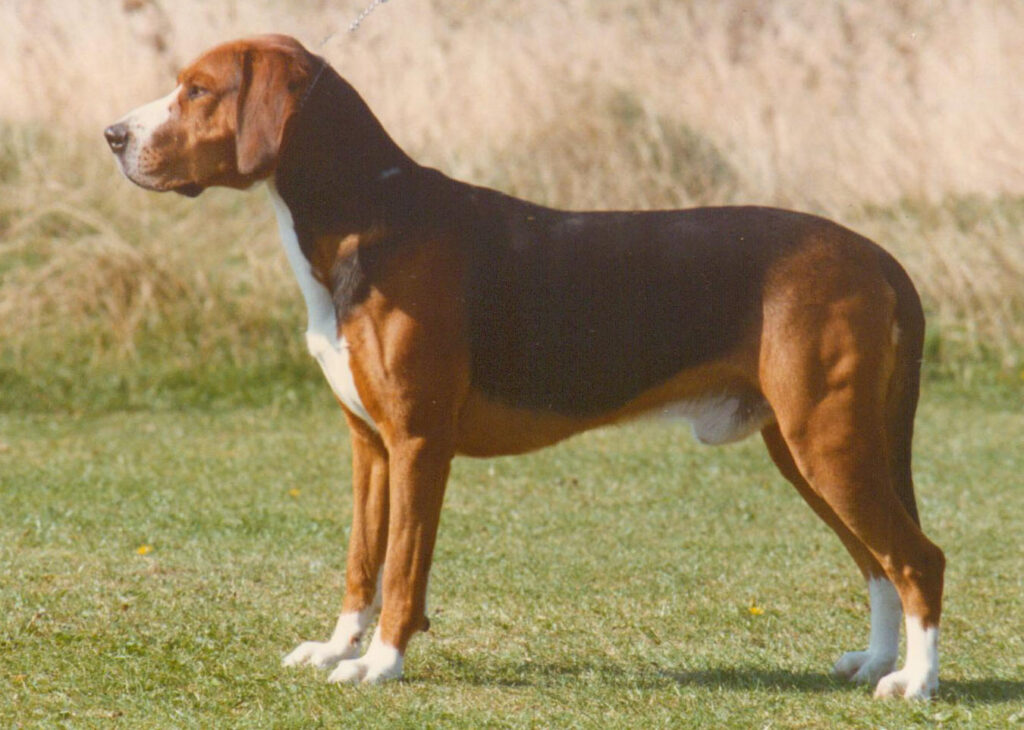
‘Mimmi’ produced three litters, the first sired by ‘Druan Dash Of Tedandi’, a daughter of
which was ‘Nz.Ch. Social Climber Of Tedandi’ and also a notable brood bitch ‘As Time Goes
By At Tedandi’, owned by Diane Cook. ‘Karat’ sired the next two litters and, from these
litters some of the most memorable Hamiltons in the UK came. The quality and uniformity
of true breed type, along with conformation and movement of the offspring of ‘Karat’ and
‘Mimmi’s’ was to be borne out in their show ring success and made ‘Mimmi’ Top Brood
Bitch All Rare Breeds 2000, 2001 & 2002, and ‘Karat’ Top Sire All Rare Breeds, for the same
years. ‘Mimmi’ & ‘Karat’s’ daughters were to become the foundation bitches for
‘Zanjadan’ (Susan & John Blane), ‘Kilcavan’ (Michelle Longman) & ‘Flixtonia’ kennels and,
although Martin & Helen Leigh had previously owned two bitches from the Tedandi lines
under a different kennel name, the ‘Flixtonia’ Kennel name was established by Angela &
Martin Leigh and eventually transferred solely to Angela.
One of the most memorable offspring from the ‘Mimmi’ & ‘Karat’ matings were ‘I’m No
April Fool I’m At Tedandi’, known as ‘Vincent’ and, although owned by the syndicate, lived
at the Tedandi Kennels and was always handled in the show ring by Diane Cook. ‘Vincent’
was the first Hamilton in the UK to win a group at Championship show level, which he
achieved twice. He was also the first Hamilton to be placed in the Hound Group at Crufts.
He was the UK’s runner-up Top Winning Hound 1998, Top Winning Rare Breed 1998 and
Top Winning Scent Hound 1999. He also won Reserve Best In Show at The Hound
Championship Show in 1998, where he was also Best Scent Hound In Show 1998 & 1999.

Judge M. Knowles with Diane Cook (handling) and the Mayoress of Bath Sylvia Cliffe
Other ‘Mimmi’ & ’Karat’offspring of note include ‘Lady Madonna At Flixtonia’ who gained
her Irish Champion title in 2004, making her the first Hamilton bitch in the world to have
the title bestowed on her. In November 2004 she gained her Dutch title, making her the
first ever dual champion title holder in the UK.

A Grandaughter of ’Lady Madonna’ was to become the Top Winning Show
Hamiltonstὄvare bitch in Europe of all time. ‘Flixtonia Lady Jane’ (Minstrel) became
Dutch / Polish / Irish / French and World Champion and won 3 groups at International
Championship Shows, including the WINNERS SHOW in Holland 2007, where she was the
first Hamilton to win a group, plus she received numerous Group placings at
Championship Shows.
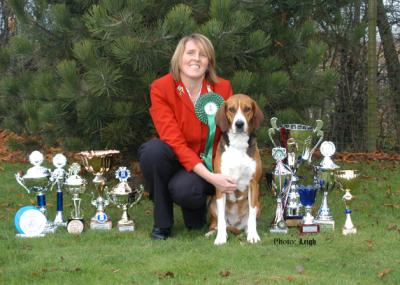
She has also went on on to produce top-winning progeny, the main one of note being her
grandson, ‘FLIXTONIA WOULD YOU BELIEVE AT TEDANDI’ who became a Nederlands
Champion in 2016 and also won a group at Maastricht Championship Show.
With the relaxation of border controls & quarantine laws in the UK it has been made
much easier to import new bloodlines from abroad and thus increase the gene pool. In
more recent years Mr & Mrs Swinburn (Bynton), Mrs. Jones (Meillion), Mr. & Mrs. Briant
(Sufayre), Miss Longman (Kilcavan) and Mrs. Leigh (Flixtonia) have imported and/or used
overseas bloodlines.
BREED DESCRIPTION (For the Breed Standard please consult the Kennel Club Website)
In 1983 The Hamiltonstὄvare Club Of Great Britain was established and a breed standard
set down. The guidelines laid down in this breed description are with the full consent and
agreement of the Officers and Committee of The Hamiltonstὄvare Club Of Great Britain
and closely follows the guidelines of The Stὄvare Club Of Sweden.
Club secretary: Michael Cook, Koivula, Station Road, Hubberts Bridge, Boston,
Lincolnshire, PE20 3QT. Tel: (+44) (0) 01205 290657.
Email: mickandditedandi@btinternet.com
,
,
HEAD AND SKULL
The head should be longish, rectangular, with a slightly arched and moderately broad
skull. The occiput should not be too prominent. Stop should be well defined but not over
exaggerated. Jowls should not be too heavy. Muzzle should be fairly long, large and
rectangular and the bridge of the nose straight and parallel to the line of the skull. The
Nose should always be black, well developed and with large nostrils. The upper lips should
be full but not too overhanging,
FAULTS: Lack of length of foreface. Rounded skull, giving a beagle-like head appearance.

EYES
The eyes should be clear, dark brown and have a tranquil expression.
FAULTS: Light eye and/or hard expression.
EARS
The ears should be moderately highly placed and, when paying attention, only slightly
raised over the crown. When drawn alongside the jaw the ears should extend to
approximately halfway along the muzzle. The ears should be soft, with straight fall and
fore edge not folding out.

BITE
Scissor bite with powerful well placed teeth. Complete dentition.

NECK
The neck should be long and powerful, merging well into the shoulders. The skin on neck
supple and close fitting.
BODY
Back straight and powerful. Strong, broad muscular loins with the croup slightly inclined.
The chest should be deep with ribs moderately sprung; the back ribs proportionately long.
Belly slightly tucked up.
FAULTS Slab sided, barrel chested, short backed, dipped backed, roached backed which is
usually coupled with an over-steep croup, resulting in bad hind action and incorrect lowset tail.

FOREQUARTERS
The shoulders should be muscular and well laid back. When viewed from the front, the
forelegs should appear straight and parallel. The return of upper arm should be long and
broad, ideally set at a right angle to the shoulder blade. Elbows should be set close to the
body.
FAULTS: Upright shoulders, lack of length of upper arm, giving a hackney/terrier front
movement. Should not stand toeing in or out.

HINDQUARTERS
Should be strong and parallel when viewed from behind with good angulation. Muscle
should be well developed and broad when viewed from the side.
FAULTS: Lack of width of thigh. Over angulation which tends to cause weakness of hocks
and close behind movement.

FEET
The feet should be compact, pointing straight forward with short well arched toes. The
pads should be well developed and firm. Dew claws allowed on front legs only.
FAULTS: Flat feet. Spayed toes.

TAIL
The tail should be set on high (approximately one-third down length of croup in almost a
straight continuation of line of back and should reach to the hocks. Powerful at the base
and narrowing off towards the tip. It should be held in a straight position or curving
slightly in a sabre-like shape when the dog is moving. Tip of tail should be white.
FAULTS: Lack of white tip to tail. Lack of length and incorrect set.

COAT
The coat should consist of two layers with a short undercoat, close and soft and especially
thick during winter. The upper coat should be strongly weather resistant lying close to the
body. On the underside of the tail the hair should be quite long but not forming a fringe.
FAULTS: Single coat
COLOUR
The upper side of the neck, the back, the sides of the trunk and the upper side of the tail
should be black. Head and legs, as well as the side of the neck, the trunk and the
underside of the tail should be brown (tan). The blaze on the upper part of the muzzle, the
underside of the neck, the breast and the tip of the tail, together with the lower leg and
feet, should be white. A Mixture of black & brown in undesirable as is any preponderance
of any of the three permissible colours. Puppies are born with their white markings, but
the tan on the head, ears and legs comes through gradually and some lines can take
several years to do so.

FAULTS: Lack of white tip on tail. Lack of white feet. Large white marking on back of neck
and side of neck.

GAIT/MOVEMENT
Free striding and long reaching. Hind legs showing drive. Should not move close behind.
FAULTS: Should not cross in front or behind. Should not pin-in in front. Should not move
close behind.

HEIGHT: Dogs 53-61 cms (21-24 ins). Ideal size 57 cms (22 ½ ins).
Bitches 49-57 cms (19 ¼ – 22 ½ ins). Ideal size 53 cms (21 ins).
BODY: Level topline. RECTANGULAR body.
HEAD: Rectangular, length of foreface should be at least as long as from occiput to stop.
Lack of foreface gives the dog an untypical beagle head.
COLOUR: Correctly marked, showing full black ‘blanket’. Ideal tan and white markings.

HEALTH ISSUES
Whilst there are few major health issues in the breed there have been, and still are some
issues with epilepsy and diabetes. These have, in the past, been more predominant than
they are today. As Epilepsy cannot be screened for it is a problem which some breeders
choose to ignore or deny. This issue is not isolated to the UK but to breeders worldwide,
even in Sweden. The more responsible breeders have attempted to eradicate these
problems by not using affected stock and going to ‘clear’ bloodlines for breeding. Whilst
not widely heard of it should be made clear that a problem still exists.
GENERAL OBSERVATIONS AND ADVICE
Whilst this is a most beautiful looking hound it is certainly not for everyone, being
headstrong and determined. It cannot, except in extremely rare cases, be let off the
lead, as its natural hunting instincts will prevail and no amount of ‘calling’ will bring
him back. Even in Sweden, when hunting, the Hamiltons often wear GPS collars, so
that they can be traced.
The Hamilton is a very vocal breed which can often cause problems with close
neighbours. It is a breed which hates to be left alone and has been known to cause
much damage to property. There have been known cases where a Hamilton has eaten
the entire interior of a car, right down to the gear-stick knob and roof lining, and also
an extreme case of a Hamilton chewing its way through the wall of a timber-built
house, in order to escape. If you seriously chastise this breed you will totally destroy
his temperament and cause him to lose all respect for you. Anyone who goes out to
work and thinks that they can leave a Hamilton for many hours alone are seriously
misguided. In this case ‘Doggy Day Care’ at a local kennels or bringing in a dog sitter
should be considered.
The Hamilton needs much exercise and ideally a large FENCED-IN area to run in. Two
GOOD walks a day are recommended.
Anyone considering owning this breed is strongly advised to take advice from a
reputable and respected breeder before taking on a puppy.
ALTERNATIVE ACTIVITIES
AGILITY:
Being mindful of the exercise a Hamiltonstὄvare requires, especially as they are not
used for hunting in the UK, some owners have chosen alternative methods of
occupying the minds of their ‘best friends’. Martin Posnette & Carol Day’s ‘Murphy’
was a successful agility competitor.
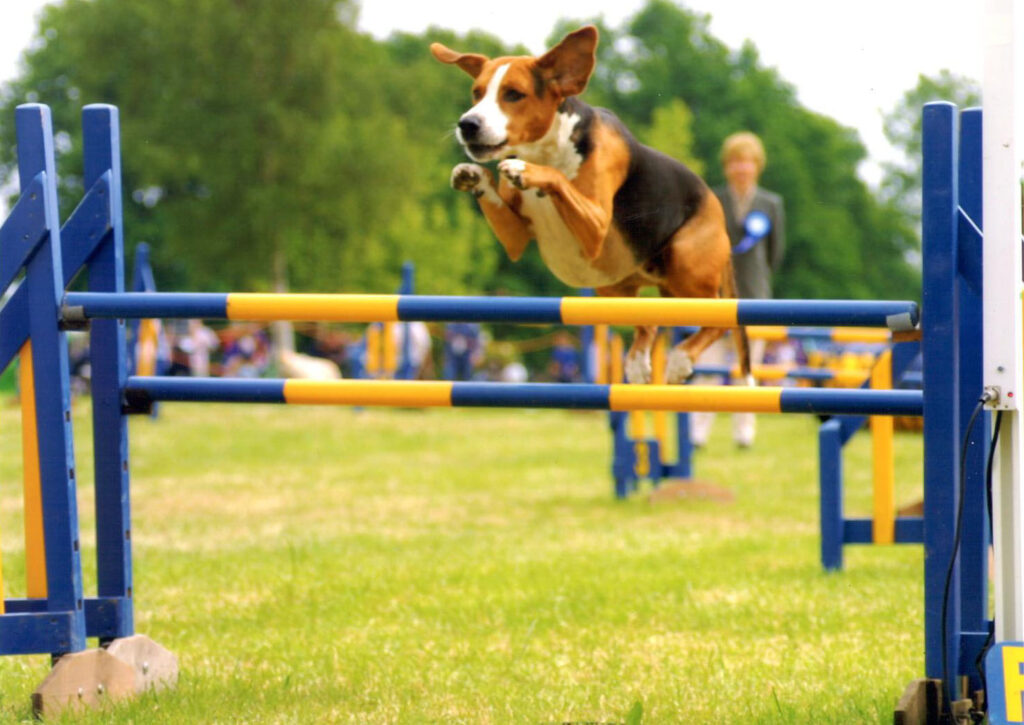

CANICROSS:
Canicross is Cross Country running with a dog, the dog being attached to the runner via an
elasticated line connected to the dog’s harness from the runner’s hip/waist belt. Dog and
runner work as a team, with the dog pulling out in front and obeying such commands as
“Go” or “Steady”. Briar and Barbara Morris started Canicross eventing in 2006 and, in
2012, visited the Discover Dogs stands Crufts where they met Hamilton breeder, Angela
Leigh and asked her thoughts on a Hamilton taking part in Canicross. A year later, ‘Dennis’
(Flixtonia Reason To Believe) was born, joined Barbara & Briar, and 18 months later
began eventing, to eventually become the world’s first Hamiltonstὄvare Canicross
champion in 2016.
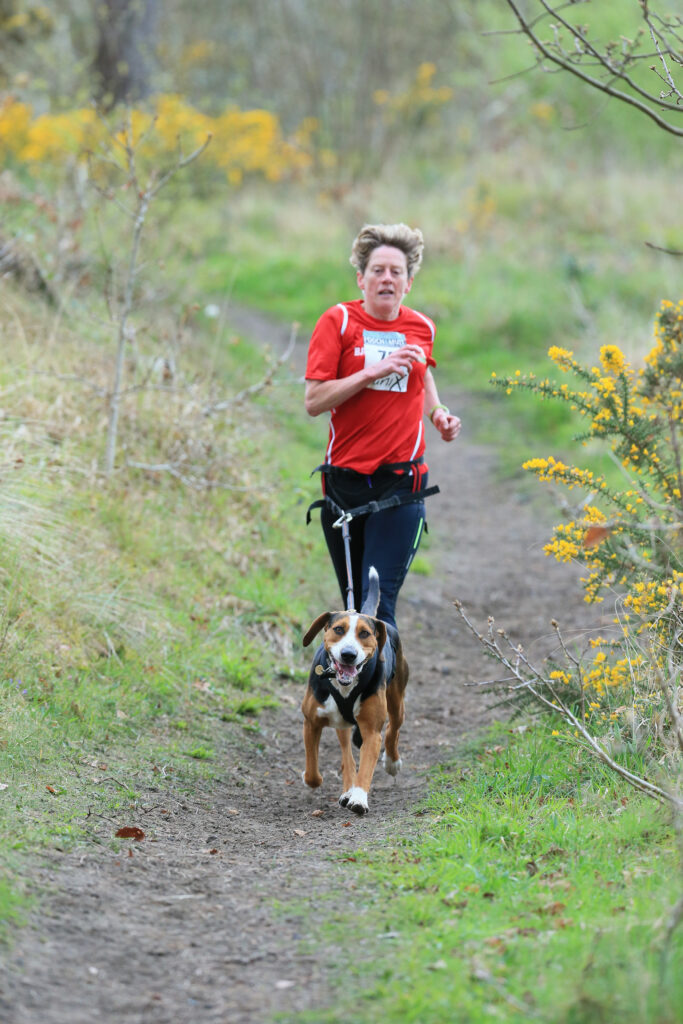
Canicross is fun for both dog & runner….Barbara & Briar Morris, still laughing as they
race to the finishing line with ‘Dennis’ the Hamilton and ‘Derek’, their beagle.
TRACKING:
Barbara & Briar Morris acquired their second Hamilton ‘Dexter’ (Flixtonia Come Fly With
Me) in 2016. They joined the UK Tracking Dog Association and Avon Working Trials
Training Group, in order to keep Dexter’s mind active at his young age. He was so
successful that, after just 3 months, Dexter had passed his UK Tracking Dog Foundation
Tracking Test and is currently working on the next training level, showing the tremendous
scenting abilities of a Hamiltonstὄvare.
I would like to extend my most grateful thanks to Michael Cook, Secretary of The
Hamiltonstὄvare Club Of Great Britain, for his invaluable input of historical information and
photos. (M. Leigh).